Heading out the door? Read this article on the new Outside+ app available now on iOS devices for members! Download the app.
Curious about the Iyengar method but too intimidated to try it? Does the pose instruction in your vinyasa class feel watered down? Sign up now for Yoga Journal’s Iyengar 101: A 6-Week Master Class on Iyengar Yoga’s Legendary Poses and Principles. Our adventurous Iyengar class is a fun, creative journey that will profoundly deepen and transform your approach to yoga and teach you everything you need to know about BKS Iyengar’s unique method. Join Senior Intermediate Iyengar teacher Carrie Owerko and Yoga Journal in the first-ever interactive online course, where Carrie creatively applies playfulness and joy to a method often perceived as strict and alienating.
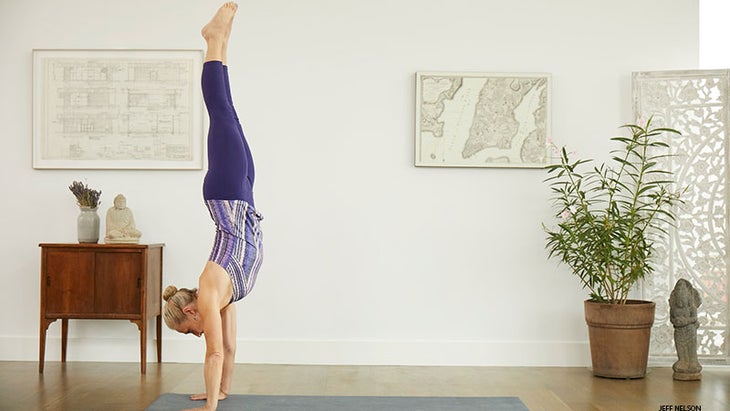
Building strength and balance in yoga doesn’t always have to feel like work. I use this dynamic, mini sequence—from Down Dog (Adho Mukha Svanasana) to Half Moon Pose (Ardha Chandrasana)—as a fun moving meditation to find core and leg stability. As you practice, pay attention to how many parts of your body are touching the ground at any given time. Learn to link the awareness of your base, or the part of you that is touching the ground, with the various parts of you that are suspended or flying through space. This playful dance of attention can bring both stability and lightness to your practice, especially to the posture Half Moon.
As you practice, observe how, as your base gets smaller (as in one or two points), the balance challenge increases. See if you can pause, even momentarily, in Half Moon Pose or Handstand, using the strength of your core to keep you stable. Keep watching your base, and start to thread your awareness from your base through the rest of your body. Then explore how you are using your breath. Try the movements while inhaling, then while exhaling. Observe how the breath influences your base and your ability to balance.
Remember, it’s not necessary to jump high in this sequence or to jump at all. You can even try stepping through these movements with a sense of lightness and buoyancy, as if you were jumping.
“Think light, feel light.” —BKS Iyengar
Downward-Facing Dog Pose
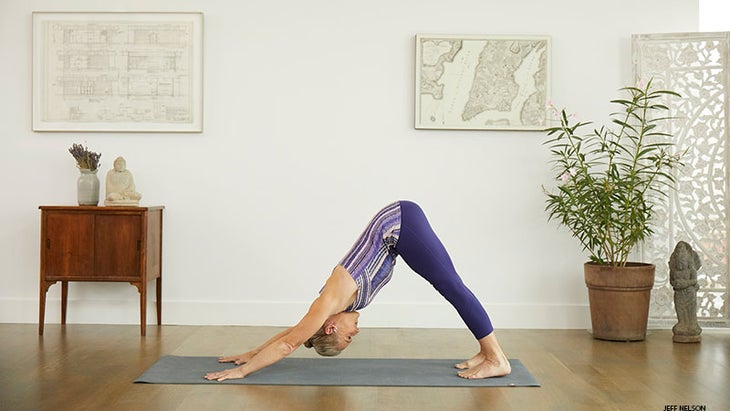
Adho Mukha Svanasana
Begin in Downward-Facing Dog (Adho Mukha Svanasana). Observe your two palms and two feet connecting into the earth. These are four stable points of contact connecting you to the ground. From your base, draw the skin and muscles of your arms and legs in toward your bones. Elongate the sides of your trunk as you broaden your shoulder blades. Press your shoulder blades into your back ribs. Use the dynamic elongation of your arms and legs to help lift your hips high into the air. Take a couple of breaths.
Standing Splits Variation
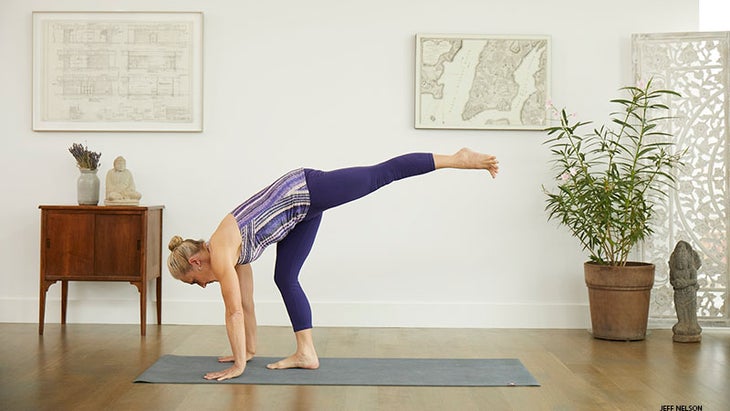
Transition to Half Moon Pose
From Down Dog, inhale as you bend your knees. With an exhalation, jump up and onto your hands, lifting both of your feet off of the ground so that your base (briefly) is only your two hands. Then land on your right foot. Be sure to bend your right knee as you land, but keep your left leg absolutely straight like an arrow or the tail of an airplane. Your right foot and your two hands are now your three-point base.
Half Moon Pose
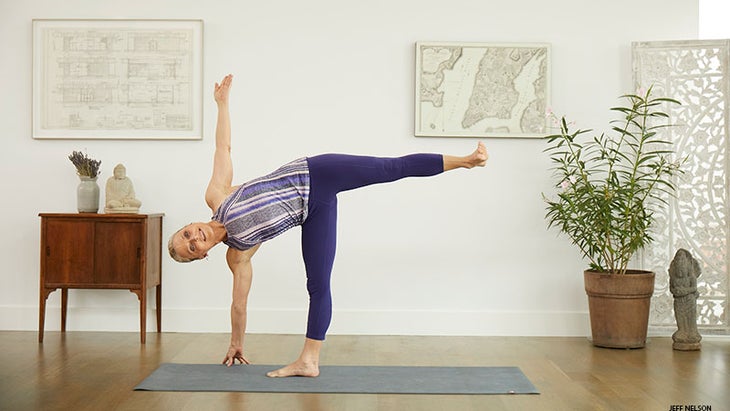
Ardha Chandrasana
Take a breath, and as you exhale, take your left hand off the floor and revolve your pelvis around your right thighbone. Continue revolving your pelvis and spine away from the floor as you come into Half Moon Pose. Now you have a two-point base (your right hand and right foot). Continue breathing and balancing and, if possible, turn your head and look up to the ceiling.
Standing Splits Variation
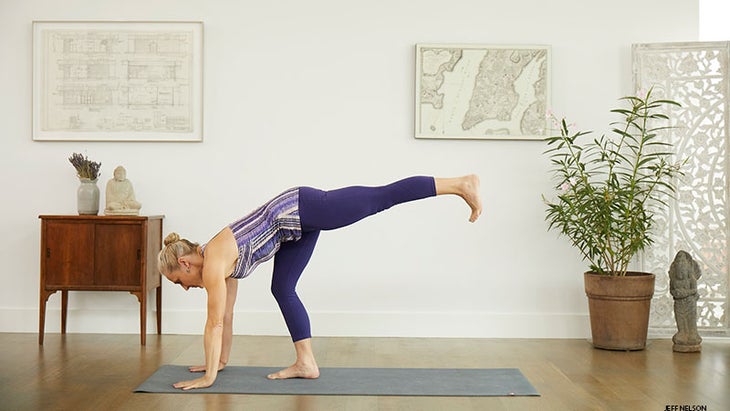
Transition to Handstand
With an exhalation, come back to your three-point base by turning your pelvis and trunk until your torso is again facing the floor. Place your left hand back on the floor.
Handstand

Adho Mukha Vrksasana
Take another breath. Then, on your next exhalation, jump up toward Handstand (Adho Mukha Vrksasana). Pause momentarily if you can and click your heels together. You now have a two-point base.
Downward-Facing Dog Pose
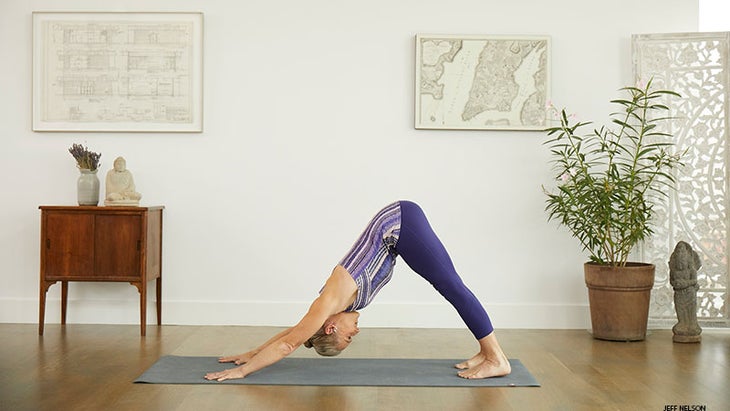
Adho Mukha Svanasana
After balancing briefly, land back in Down Dog. Make sure to bend your knees to soften your landing. Learn to use your core to land both feet at the same time, so that you arrive back where you started with your four-point base in Adho Mukha Svanasana.
About Our Expert
Carrie Owerko is a Senior Intermediate Iyengar teacher based in New York City. She continues her studies with the Iyengar family by traveling to India on a regular basis, as well as by continuous in-depth studies with her yoga teacher, Patricia Walden. Before studying yoga, Carrie earned a BFA in dance and theater and became a Certified Movement Analyst. Curiosity, openness, and affection are of utmost importance in her approach to Iyengar Yoga, as is the integration of science, yoga philosophy, and poetic imagination. Most importantly, she loves to explore the relationship of discipline and playfulness and is a firm believer in the power of controlled folly. Learn more at carrieowerko.com